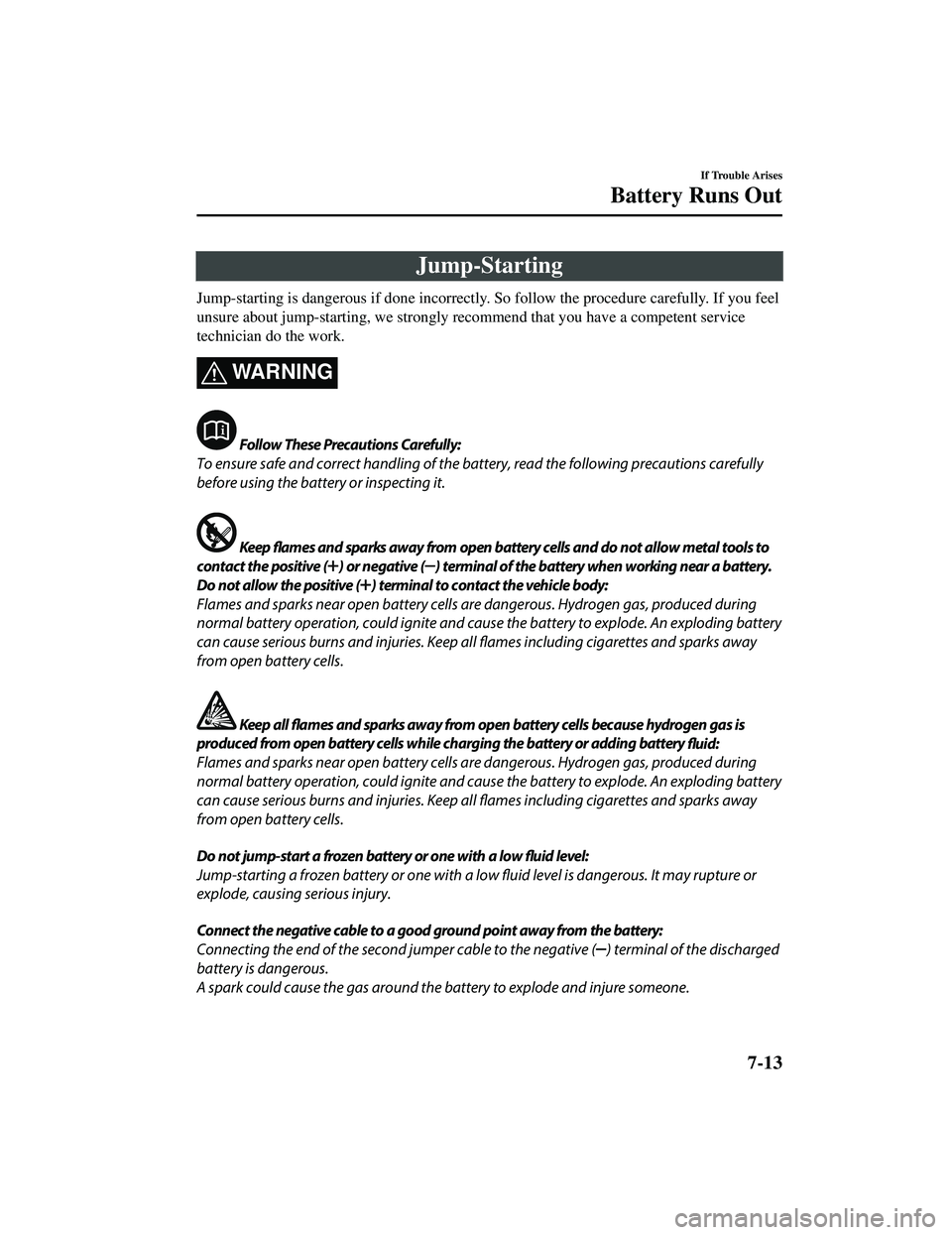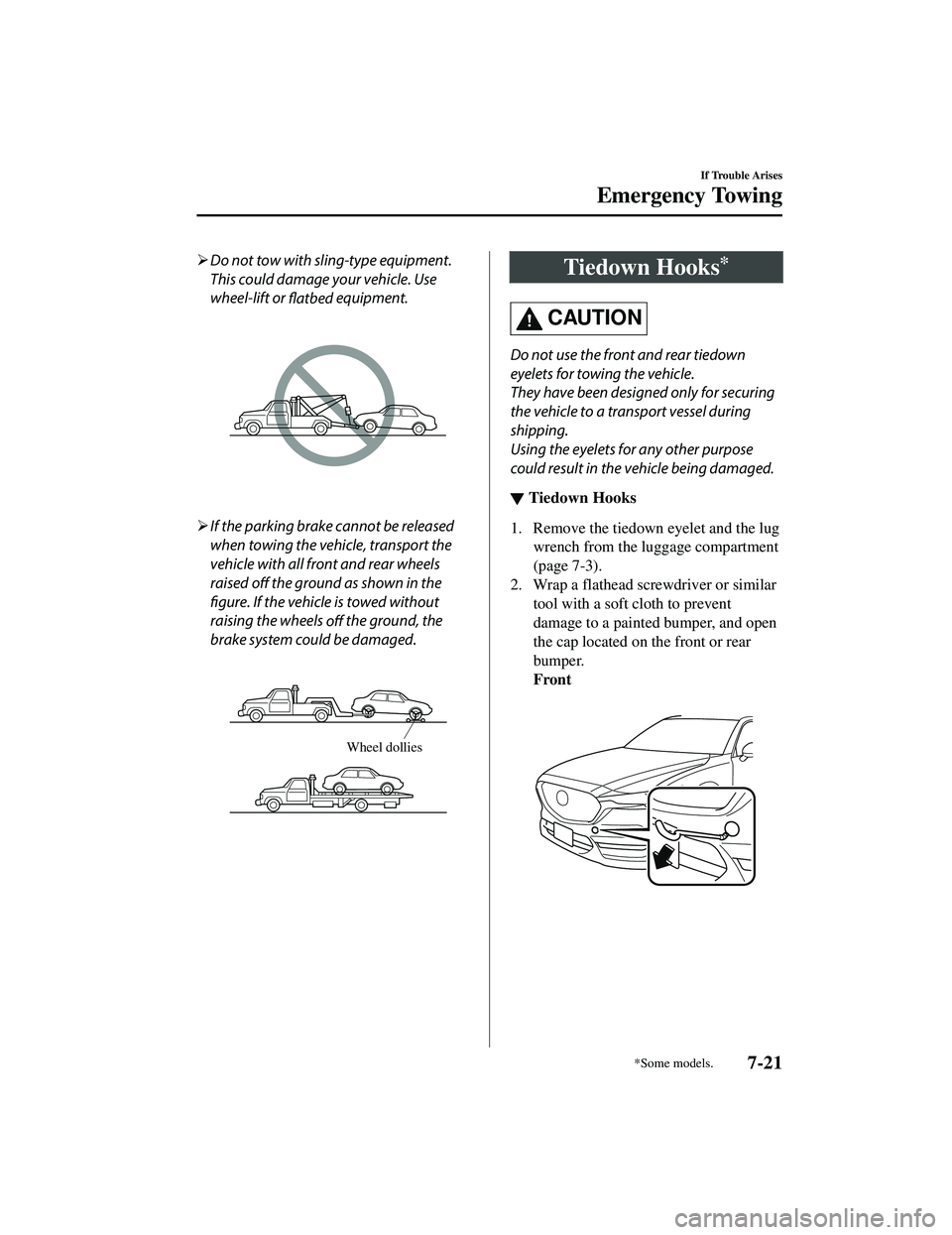MAZDA MODEL CX-5 2021 Owners Manual
Manufacturer: MAZDA, Model Year: 2021, Model line: MODEL CX-5, Model: MAZDA MODEL CX-5 2021Pages: 715, PDF Size: 10.62 MB
Page 601 of 715

8. Place the luggage board on thedamaged tire.
Luggage board
9. Remove the tire blocks and store thetools and jack.
10. Check the inflation pressure. Refer to Tires on page 9-8.
11. Have the flat tire repaired or replaced as soon as possible.
WA R N I N G
Do not drive with any tires that have
incorrect air pressure:
Driving on tires with incorrect air pressure
is dangerous. Tires with incorrect pressure
could affect handling and result in an
accident. When you check the regular tires'
air pressure, check the spare tire, too.
NOTE
To prevent the jack and tool from rattling,
store them properly.
If Trouble Arises
Flat Tire
7-12
CX-5_8JM9-EA-20G_Edition6_old 2021-12-9 11:43:53
Page 602 of 715

Jump-Starting
Jump-starting is dangerous if done incorrectly. So follow the procedure carefully. If you feel
unsure about jump-starting, we strongly recommend that you have a competent service
technician do the work.
WARNING
Follow These Precautions Carefully:
To ensure safe and correct handling of the ba ttery, read the following precautions carefully
before using the battery or inspecting it.
Keep flames and sparks away from open battery cells and do not allow metal tools to
contact the positive (
) or negative () terminal of the battery when working near a battery.
Do not allow the positive (
) terminal to contact the vehicle body:
Flames and sparks near open battery cells are dangerous. Hydrogen gas, produced during
normal battery operation, could ignite and cause the battery to explode. An exploding battery
can cause serious burns and injuries. Keep al l flames including cigarettes and sparks away
from open battery cells.
Keep all flames and sparks away from open battery cells because hydrogen gas is
produced from open battery cells while charging the battery or adding battery fluid:
Flames and sparks near open battery cells are dangerous. Hydrogen gas, produced during
normal battery operation, could ignite and cause the battery to explode. An exploding battery
can cause serious burns and injuries. Keep al l flames including cigarettes and sparks away
from open battery cells.
Do not jump-start a frozen battery or one with a low fluid level:
Jump-starting a frozen battery or one with a low fluid level is dangerous. It may rupture or
explode, causing serious injury.
Connect the negative cable to a good ground point away from the battery:
Connecting the end of the second jumper cable to the negative (
) terminal of the discharged
battery is dangerous.
A spark could cause the gas around the battery to explode and injure someone.
If Trouble Arises
Battery Runs Out
7-13
CX-5_8JM9-EA-20G_Edition6_old 2021-12-9 11:43:53
Page 603 of 715

Route the jumper cables away from parts that will be moving:
Connecting a jumper cable near or to moving parts (cooling fans, belts) is dangerous. The
cable could get caught when the engine starts and cause serious injury.
CAUTION
Use only a 12 V booster system. You can damage a 12 V starter, ignition system, and other
electrical parts beyond repair with a 24 V power supply (two 12 V batteries in series or a 24 V
motor generator set).
1. Move the booster vehicle so that its battery is as close as possible to your vehicle's battery.
2. Make sure that the power such as for the headlights and air conditioner is turned off.
3. Remove the battery cover.
4. Turn off the booster vehicle's engine and connect the jumper cables in the following
order.
Make sure that the jumper cables are securely connected so that they do not disconnect
due to engine vibrations.
1st lead
Positive (+) terminal on the discharged battery
Positive (+) terminal on booster vehicle's battery
2nd lead
Negative (-) terminal on booster vehicle's battery
If Trouble Arises
Battery Runs Out
7-14
CX-5_8JM9-EA-20G_Edition6_old 2021-12-9 11:43:53
Page 604 of 715

Location shown in the figure (do not connect to the negative (-) terminal of the
battery)
Booster batteryDischarged battery
Jumper cables
Connect cables in numerical order
and disconnect in reverse order.
5. Start the booster vehicle's engine and rev the engine.
6. Start the engine of your vehicle. Run the engines for about 3 minutes to temporarily
charge the battery of your vehicle.
7. Disconnect the jumper cables in th e reverse order of their connection.
8. Install the battery cover.
9. Have your vehicle inspected by an Authorized Mazda Dealer as soon as possible.
NOTE
Verify that the covers are securely installed.
If Trouble Arises
Battery Runs Out
7-15
CX-5_8JM9-EA-20G_Edition6_old 2021-12-9 11:43:53
Page 605 of 715

Starting a Flooded Engine(SKYACTIV-G 2.5 andSKYACTIV-G 2.5T)
If the engine fails to start, it may be
flooded (excessive fuel in the engine).
Follow this procedure:
1. If the engine does not start within 5
seconds on the first try, wait 10
seconds and try again.
2. Make sure the parking brake is on.
3. Depress the accelerator all the way and hold it there.
4. Depress the brake pedal, then press the push button start. If the engine starts,
release the accelerator immediately
because the engine will suddenly rev
up.
5. If the engine fails to start, crank it without depressing the accelerator.
If the engine still does not start using the
previous procedure, have your vehicle
inspected by an Authorized Mazda Dealer.
Push-Starting
Do not push-start your Mazda.
WA R N I N G
Never tow a vehicle to start it:
Towing a vehicle to start it is dangerous.
The vehicle being towed could surge
forward when its engine starts, causing the
2 vehicles to collide. The occupants could
be injured.
NOTE
You cannot start a vehicle with an
automatic transaxle by pushing it.
If Trouble Arises
Emergency Starting
7-16
CX-5_8JM9-EA-20G_Edition6_old 2021-12-9 11:43:53
Page 606 of 715

Running Out of Fuel(SKYACTIV-D 2.2)
CAUTION
Do not try starting the engine for more
than 10 seconds at a time. Doing so, could
damage the starter. If the engine does not
start on the first try wait about 20 seconds
(only after refueling from an empty tank)
before trying again.
If your vehicle runs out of fuel, add at
least 10 L (2.6 US gal, 2.2 Imp gal) of
diesel fuel, and try to restart the engine.
Because air can get into fuel lines when a
vehicle runs out of fuel, your engine may
take longer to start. If the engine does not
start the first time, try starting it several
more times. If it still does not start, contact
an Authorized Mazda Dealer.
If Trouble Arises
Emergency Starting
7-17
CX-5_8JM9-EA-20G_Edition6_old 2021-12-9 11:43:53
Page 607 of 715

Overheating
If the temperature gauge indicates
overheating or the high engine coolant
temperature warning light turns on, the
vehicle loses power, or you hear a loud
knocking or pinging noise, the engine is
probably too hot.
WA R N I N G
Pull over to a safe location, then switch
the ignition off and make sure the fan is
not running before attempting to work
near the cooling fan:
Working near the cooling fan when it is
running is dangerous. The fan could
continue running indefinitely even if the
engine has stopped and the engine
compartment temperature is high. You
could be hit by the fan and seriously
injured.
Do not remove either cooling
system cap when the engine and radiator
are hot:
When the engine and radiator are hot,
scalding coolant and steam may shoot out
under pressure and cause serious injury.
Open the hood ONLY after steam is no
longer escaping from the engine:
Steam from an overheated engine is
dangerous. The escaping steam could
seriously burn you.
If the temperature gauge indicates
overheating or the high engine coolant
temperature warning light turns on:
1. Drive safely to the side of the road and
park off the right-of-way.
2. Shift into park (P).
3. Apply the parking brake.
4. Turn off the air conditioner.
5. Check whether coolant or steam is escaping from the engine
compartment.
If steam is coming from the engine
compartment:
Do not go near the front of the vehicle.
Stop the engine.
Wait until the steam dissipates, then
open the hood and start the engine.
If neither coolant nor steam is
escaping:
Open the hood and idle the engine
until it cools.
CAUTION
If the cooling fan does not operate
while the engine is running, the engine
temperature will increase. Stop the
engine and call an Authorized Mazda
Dealer.
6. Make sure the cooling fan is operating, then turn off the engine after the
temperature has decreased.
7. When cool, check the coolant level.
If Trouble Arises
Overheating
7-18
CX-5_8JM9-EA-20G_Edition6_old 2021-12-9 11:43:53
Page 608 of 715

If it is low, look for coolant leaks from
the radiator and hoses.
If you find a leak or other damage, or if
coolant is still leaking:
Stop the engine and call an Authorized
Mazda Dealer.
SKYACTIV-G 2.5
Cooling system
cap
Coolant
reservoir
Cooling fan
SKYACTIV-G 2.5T
Cooling system cap
Coolant reservoir
Cooling fan
SKYACTIV-D 2.2
Cooling system capCoolant
reservoir
Cooling fan
If you find no problems, the engine is
cool, and no leaks are obvious:
Carefully add coolant as required (page
6-26).
CAUTION
If the engine continues to overheat or
frequently overheats, have the cooling
system inspected. The engine could be
seriously damaged unless repairs are
made. Consult an Authorized Mazda
Dealer.
If Trouble Arises
Overheating
7-19
CX-5_8JM9-EA-20G_Edition6_old 2021-12-9 11:43:53
Page 609 of 715

Towing Description
We recommend that towing be done only
by an Authorized Mazda Dealer or a
commercial tow-truck service.
Proper lifting and towing are necessary to
prevent damage to the vehicle. Particularly
when towing an AWD vehicle, where all
the wheels are connected to the drive train,
proper transporting of the vehicle is
absolutely essential to avoid damaging the
drive system. Government and local laws
must be followed.
Wheel dollies
A towed FWD vehicle should have its
drive wheels (front wheels) off the ground.
If excessive damage or other conditions
prevent this, use wheel dollies.
When towing a FWD vehicle with the rear
wheels on the ground, release the parking
brake.
Refer to Electric Parking Brake (EPB) on
page 4-98.
A towed AWD vehicle must have all its
wheels off the ground.
WA R N I N G
Always tow an AWD vehicle with all four
wheels off the ground:
Towing an AWD vehicle with either the
front or rear wheels on the ground is
dangerous as the drive train could be
damaged, or the vehicle could trail away
from the tow truck and cause an accident.
If the drive train has been damaged,
transport the vehicle on a flatbed truck.
CAUTION
Do not tow the vehicle pointed backward
with driving wheels on the ground. This
may cause internal damage to the
transaxle.
If Trouble Arises
Emergency Towing
7-20
CX-5_8JM9-EA-20G_Edition6_old 2021-12-9 11:43:53
Page 610 of 715

Do not tow with sling-type equipment.
This could damage your vehicle. Use
wheel-lift or
flatbed equipment.
If the parking brake cannot be released
when towing the vehicle, transport the
vehicle with all front and rear wheels
raised
off the ground as shown in the
figure. If the vehicle is towed without
raising the wheels off the ground, the
brake system could be damaged.
Wheel dollies
Tiedown Hooks*
CAUTION
Do not use the front and rear tiedown
eyelets for towing the vehicle.
They have been designed only for securing
the vehicle to a transport vessel during
shipping.
Using the eyelets for any other purpose
could result in the vehicle being damaged.
▼ Tiedown Hooks
1. Remove the tiedown eyelet and the lug
wrench from the luggage compartment
(page 7-3).
2. Wrap a flathead screwdriver or similar tool with a soft cloth to prevent
damage to a painted bumper, and open
the cap located on the front or rear
bumper.
Front
If Trouble Arises
Emergency Towing
*Some models.7-21
CX-5_8JM9-EA-20G_Edition6_old 2021-12-9 11:43:53